#princess in her hennin and veil
Explore tagged Tumblr posts
Text

Please to give Guinevere ALL of your attention. Thank you.
Oooh, you can really tell that Guinevere likes to maintain her own coat. There are bits of sticky or dry or tangled hairs that usually she would groom herself. A couple of mats forming under the cone and I can't reach them with it on. The inside of the cone smells like a vacuum cleaner bag despite my best efforts to keep her ears clean.
She gets her stitches out today! Then we can finally get that lampshade off. I will take care of the urgent stuff right away, and she's getting thorough grooming on Monday.
#guinevere#cocker spaniel#dogblr#princess in her hennin and veil#please play with Gwyn#the butt hurts#I think Tristan will appreciate the cone off more than anyone else#so she stops smacking at him with it when she tries to boop his face#neither of them understands why Gwyn suddenly acquired an unpredictable force field around her head
29 notes
·
View notes
Text

Happy Broppy Day!
I wanna start this collection out by drawing Branch and Queen Poppy in their medieval fantasy AU outfits. Their outfits are inspired by 15th century medieval fashion, known for their fancy hats and the iconic princess headdresses. Queen Poppy wears a gown that matches her crown and the hennin (a cone-shaped hat with a veil) with flower jewelry while Branch is dressed in a surcoat with billowy sleeves, pants, and boots, which were fit for an aristocrat because he is the ruling lord of a patch of land in Queen Poppy’s kingdom, a skilled knight, and the current head of one of the high esteemed noble families.
Maybe I’ll work on Holly Darlin’ and Lil’ Ted for @jade-green-butterfly’s birthday for the next part of the collection.
20 notes
·
View notes
Note
Well, i'm not sure. LOZ isn't he most fastidious when it comes to fashion history XD
Specifically referring to Zelda, her headcovering was probably inspired by a mixture of a veil or a wimple


and some varities hennin and hennin-adjacent headcoverings

as to when they would have become popular in Hyrule? I'm not really sure. In real life, a veil or wimple was what everyone wore throughout most of the middle ages up into the Renaissance (though Italy began to drop it first), so if Hyrule was to mirror our world in that more people would be wearing them and... probably would have started by the time of minish cap, as Minish Cap demonstrates that fashions have already begun to shift into more stereotypical medieval western europe inspired styles, contrasted with the styles from Skyloft.
another possibility is this

the Skyward Sword statues of Hylia seem to be wearing some sort of veil or headcovering, which is either layered or embroidered to appear like feathers, or has feathers attached too the cloth. (Perhaps this is the sailcloth that Zelda was wearing as part of her goddess attire in the beginning, as the statue does not have anything around her shoulders?) This is clearly a separate garment from her hair, as you can see the hair on her forehead and the embroidered hem of the garment.
this continues on to the latest depiction of Hylia we have

where she is still depicted as donning some sort of veil or wimple.
My theory is that the veil came to be associated with the royal family because of the statue in the earlier days of hyrule the kingdom, because of hte princess' connection to the goddess, perhaps a part of attire worn for formal occassion or religious festivals. Eventually, by the time of OOT, the veil may have migrated into a princess' everyday attire, even though by this point Hylia had become an obscure goddess.
...was any of that helpful, Lofty?
So lofty, are wedding veils a thing in skyloft and early hyrule? And if they are when do you think veils/goods/caps became daily wear like we see with princess Zelda in OoT
I went on a “history of clothing in different parts of the world” dive for funsies, and I’m gonna say no to veils. Skyloftian women wear the most colorful dresses they have (that match the color scheme of their loftwings) and then they can repurpose the dress for later usage in a less formal setting. They do decorate their hair with ornaments and intricate styles though! The grooms do too. 👍🏻
As for when veils and hoods and caps became popular, it had to have been sometime between Minish Cap and Ocarina, I suppose. I don’t know if Minish Cap has similar fashion or not. Things do tend to come and go and return and go again, so it’s possible Time’s rra wasn’t the first to think wearing those headpieces was cool.
@telemna-hyelle You like fashion history, right? What do you think?
20 notes
·
View notes
Text
Historical costuming for period dramas is such a tricky job I feel, and also a job people don’t really get enough credit for, because in many ways you actually have to strike a balance between “historically accurate” (or, far more often, “looks historically accurate or historical in general to the average layperson,” which, as a historian, I say is not an inherently bad thing) and also “appealing to a modern audience.” For example, the historically accurate fashion in England at the time of period dramas such as The White Princess, The White Queen, etc, involving things such as tweezed eyebrows (often to the point of nonexistence; sometimes they were shaved entirely) and also severely plucked and reduced hairlines for women, would likely not be appealing for a modern audience to spend hours looking at.

(Pictured: Elizabeth Woodville, wife of Edward IV, ft. a plucked hairline with a truncated English hennin. While to some this portrait may look unfinished, those strange lines around her face actually indicate a sheer veil.)

(Pictured: Margaret of York, sister of Edward IV and Richard III, painted the year of her marriage to Charles the Bold, featuring the same plucked hairline and thin, nearly nonexistent eyebrows, under a conical hennin and veil.)
Men’s fashion might also appear silly and unsightly to a modern audience, featuring bob or “Lord Farquaad” style hairs and strange short bangs, strange shoes, and incredibly tight hoses.

(Tommaso di Folco Portinari (1428–1501) and Maria Portinari (Maria Maddalena Baroncelli, born 1456). While not in England, similar clothes were worn in England.)

(Portrait and facial reconstruction of Richard III, featuring the bob cut popular among men in England at the time of the Wars of the Roses.


(Portraits of Richard III’s brother and predecessor, Edward IV.)
Edward IV was also responsible for limiting and eventually abolishing (in England) the crackowes (or crakows, or poulaines) shoes.





Thought to have originated in Poland, these are those medieval men’s shoes (though some portraits show some women wearing similar footwear) with the ridiculously long toes, which got so long at one point that men would have to tie the toes to their legs. These shoes were introduced to England during the reign of Richard II, and during his reign Edward IV said “absolutely not” and in 1463 passed a sumptuary law (which, as someone with a JD, can be defined here as a law aimed at limiting extravagance and luxury, which were then often used to enforce social hierarchies by limiting and defining what people in certain classes could wear, even down to colours) that restricted people under certain ranks from wearing “poulaines” that were over two inches. A couple years later they were banned in England all together. Still, they would have been popular in England for the entire first part of the Wars of the Roses.
Compare some of these to stills and promotional shots from Starz’s The White Princess and The White Queen.






There are some similarities. You can tell research was done. You can also tell that some changes were made to make the show more visually appealing to a modern audience (note the conspicuous lack of pointy shoes and the inclusion of boots for men and the lack of any sort of hennin or plucked foreheads for women in particular), and I think that’s important. You do want your show to be appealing to a modern audience, because that is how you get people engaged, and that’s how more people get interested in history. Historical accuracy is important but I do think there are times when it can be sacrificed in the visual department especially to make it a bit more appealing to modern audiences, because honestly, even as a historian I am not fond of the plucked forehead trend and it wouldn’t be my favourite thing to watch on the big screen. These costumes build atmosphere, and contribute to the world the writers are developing and trying to pull you into. You look at them and it takes you to a different time, and allows the imagination to build around that. And things that, while historically accurate, might actually take an audience out of the story (such as plucked hairlines on women the likes of which you would rarely if ever see on a woman today, or pointy shoes that have you wondering how anyone even managed to walk in that time period without flopping around like a snorkeler trying to manoeuvre his flippers on land) are carefully edited as a result.
Now, conversely, people can take it too far. The CW’s Reign about the early life of Mary, Queen of Scots is a particularly egregious example of a costuming department that, for the most part, threw history entirely out the window and took their attempt to appeal to a modern audience too far, to the point where all the women look like they’re going to their junior proms (we don’t have proms in my country but looking at America it seems an apt comparison) and the men looks like they were plucked from about fifty other historical eras, none of which is the one they’re supposed to be in. This removes all suspension of belief and disbelief. In The White Princess and The White Queen (and, save for some bizarre choices, The Tudors and The Spanish Princess as well, but also other non-medieval/early modern period dramas such as Starz’s Spartacus), all the outfits chosen still look like they could be historically accurate to most people. They set the scene of a medieval court, and help build the historic atmosphere, and most people won’t know that they aren’t entirely accurate, because they’re largely consistent in their appearance and style. They help the audience connect with the time period.
Reign threw those notions out the window. The writing department also through all semblance of history out the window, but that’s a debate for another post.

(Pictured: an American prom, probably.)


(They’re pirates, Harold, and probably escapees from The Vampire Diaries.)


(What is this?)

(Why with this modern wedding gown.)

I once saw these costumes described as “Gossip Girls but in funky outfits,” or something like that. I’ve never seen Gossip Girl(s?) but I Googled it once and that seems like an apt description. Instead of helping an audience connect with the time period or build any sort of believable atmosphere, most of these dresses look like they came straight off the rack at H&M, and even audiences that don’t know anything about the time period will be able to see that clearly. It takes the audience out of the story and the time period, instead of helping to immerse them in it in a way that is still palatable to modern palettes. Lots of people still like Reign, which is fine, but this is definitely an example of a costuming department that largely took trying to connect to a modern audience a bit too far.
My point is! Historically accurate costuming is all well and good, but there are times when it can be sacrificed. Costuming must tread that balance between accurate and appealing, and while it can be fun to nitpick (I used to be insufferable about it myself), I caution against being mean-spirited and self-righteous about it, and I also caution against writing off entire series due to costuming inaccuracies (I see a lot of hate levelled at The Tudors for this which is a shame, as it’s a very unique piece of Tudor-history media and there’s a lot of really good, accurate, and well-thought-out content in it once you get past the initial stage especially), as I do think it’s important to acknowledge that it’s all right if costumes aren’t entirely period accurate, or if period accuracy is sacrificed in some ways to appeal to modern audiences and get them interested in the period in question. All that leads to more people watching, and more people watching ultimately leads to more interest in the historical period in question. Can it be taken too far? Yes. (Reign. Also that incredibly strange purple dress that Anne Boleyn wears in The Tudors with the gold trench coat-esque thing overtop.) But on the whole? As a historian? I’m all right with it. It makes history more accessible to people in many ways, and I’m always supportive of making history more accessible and less elitist.
#history#historical fashion#The White Princess#The White Queen#Reign#long post#text#historical costuming#Elizabeth Woodville#Edward IV#Richard III#Wars of the Roses#etc etc sorry everyone#chey's historical rambles
253 notes
·
View notes
Note
My witchy queen, Hatterene!
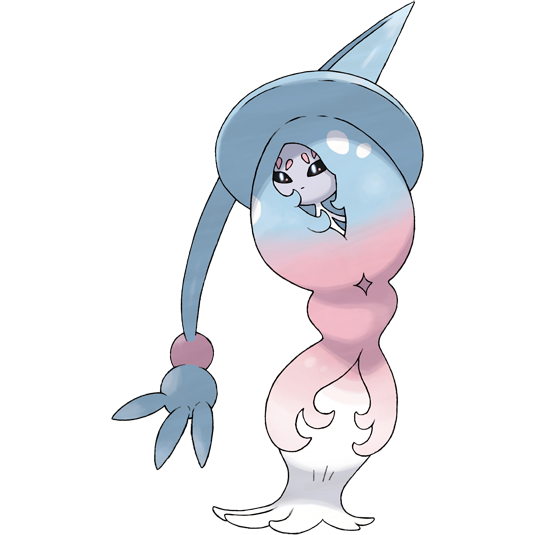
Ooooh, HATTERENE!!!!! The Forest Witch!!!!
A Psychic/Fairy-type, Hatterene’s actually my favourite new pokemon from Galar, with a stellar design and some truly superb vibes. It’s a bit difficult to actually describe, though: it’s got a humanoid silhouette, but this is misleading, as what appears to be its body is actually just hair. Its true body is still humanoid, but much smaller, terminating in a translucent dress-like appendage. It’s really quite creative, if a little aesthetically unwieldy. Here’s the model with the hair parted and the dress removed:
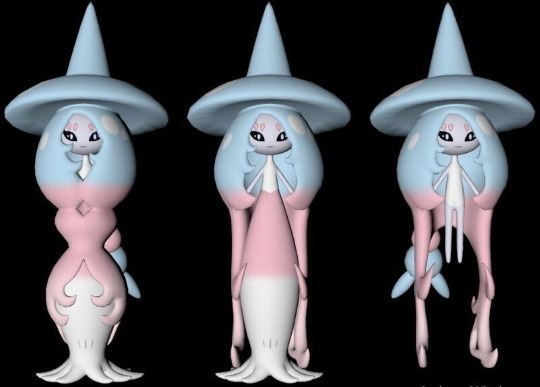
The most immediately striking part of Hatterene’s appearance is actually the witch hat-like appendage on its head, which ends with a long, prehensile tentacle with three claws. This tentacle seems to be its primary means of interacting with the world, as its short arms are held beneath its hair and never seem to be used. Because its feet don’t touch the ground, its primary means of movement is just slowly levitating, or just teleporting. You can actually see it teleport around in the Wild Area! ...Though oddly, it doesn’t actually learn Teleport.

What really makes Hatterene, though, is its dex entries. Just one sentence, rather. “If you're too loud around it, you risk being torn apart by the claws on its tentacle.” That’s terrifying. Hatterene is classified as the Silent Pokemon, and appropriately, it hates noise. It even hates the idea of noise, repelling people by giving them headaches. Its pre-evolutions, as well, avoid all intense emotions. Hatterene wants everything calm and silent, both inwardly and outwardly. That’s highly appropriate for a Psychic-type, given their tendency to be in tune with the thoughts and feelings of those around them – AND highly appropriate for a Fairy-type, with fairies’ potential for uncanny creepiness. I think it’s probably one of the strongest pokemon concepts there are. The fact it has a common name as ominous as the “Forest Witch” further enhances the concept, and I really, really love it.
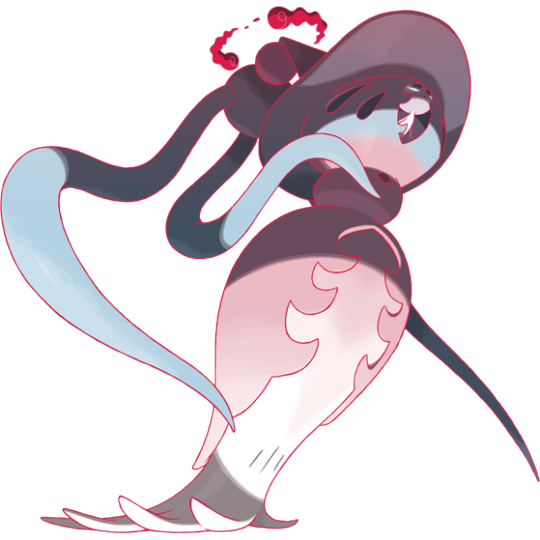
It’s also got a Gigantamax form, which isn’t too wildly different, but its hair has a notably tower-like quality to it that kinda evokes Rapunzel in her tower. Some others have noted this as well, but Hatterene actually seems to have something of a princess aesthetic going on, independent of its witch aesthetic. When you ignore the wide brim of the hat, the long tentacle actually brings to mind the veil emerging from the top of a medieval princess hat – a hat properly known as a hennin. A body made of long hair seems to directly reference Rapunzel, as well. It’s entirely possible Hatterene was created as a princess pokemon initially and the witch and silence themes got added later, with the princess aspect being put to the side. Anyways, the Gigantamax form is known as the “Raging Goddess”, and it attacks anything exhibiting hostile emotions in a 30-mile radius. Neat!

Shiny Hatterene is a lovely silver-and-coral colour, which isn’t nearly as pleasant as the trans rights pink-and-blue, but certainly a fantastic shiny nonetheless. Maybe a little bit similar to the base colours, but still distinct enough. After learning that Ability Patches exist and it wouldn’t be locked out of Magic Bounce, I’m high-key tempted to try breeding one :3
Anyways, I absolutely adore Hatterene. It’s quite possibly my favourite Psychic-type, though that’s a position with a lot of competition so it’s a very tough call. It might actually be one of my very top favourites overall, now that I think about it. A big part of my fondness stems from my adoration of witches, which should give y’all a clue of what my #1 favourite pokemon is. My only real criticism is that, like the Impidimp line, it’s gender-locked. There’s absolutely no reason that that was necessary, just as it wasn’t necessary for the Impidimp line – sure, they’re counterparts, but it’s entirely possible to be counterparts without having this weird gender-locking going on. That said, it doesn’t detract from my love for Hatterene. It’s just Game Freak’s fault >:(
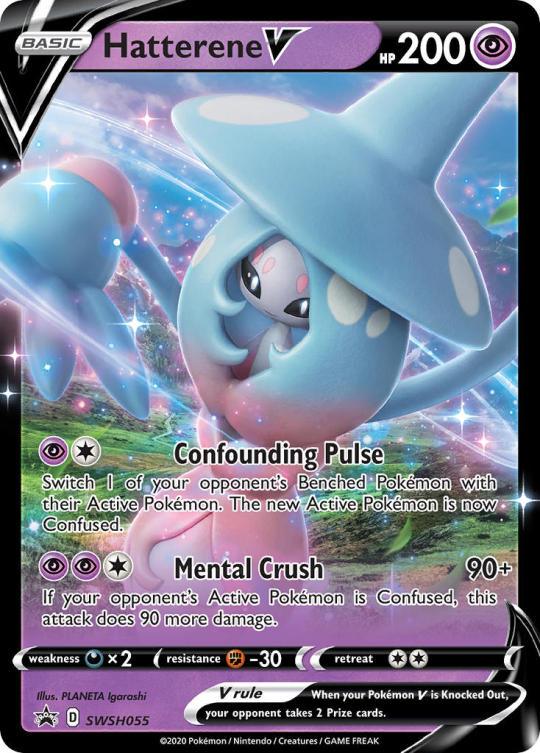
….Y’know, after doing this review, Hatterene’s actually grown on me even more. I think it might actually be my favourite pokemon now????? Previous fave usurped???? what the heck
Silence is golden/10.
#pokemon#pokemon reviews#pkmn#swsh#hatterene#hatenna#hattrem#psychic type#fairy type#gigantamax#galar#gen 8#Anonymous
87 notes
·
View notes
Text
Fantasy Wardrobe: Popular Headresses (Women) Part 1
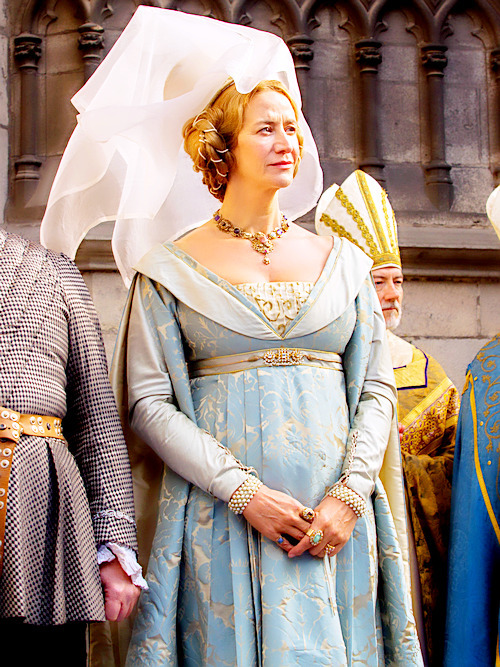
(Disclaimer: These are mostly European and from Mediaeval/Renaissance times. Other posts are coming about other periods and places so keep that in mind)
Fashion for ladies have changed throughout the centuries, no garment more so than the headdresses they wear. Statement headdresses can be an interesting component to add to your worldbuilding. The use of different styles give each culture a defined feel and could act as a symbol of all kinds of lands in your WIP.
Hennins
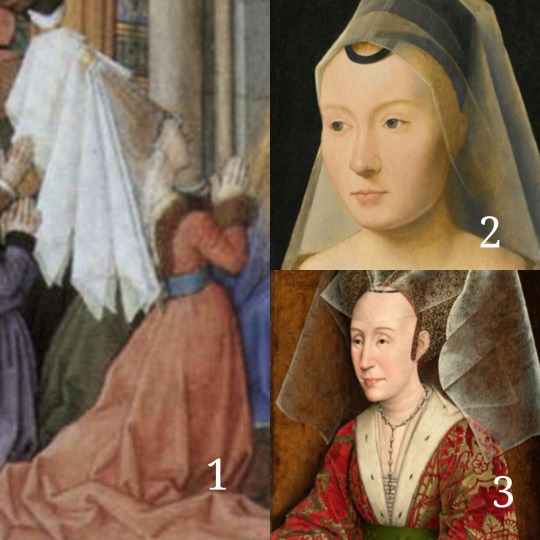
These are those headdresses. The ultimate headdress for a Princess. These headdresses made of stiffened material and draped with veils. They came in the popular cone shape (image 1), or the truncated shape/ flower pot (image 2) or the divided version (image 3). These were popular in the 15th Century, coming from the French courts and the Burgundian court.
Stickelchen Cap

This headdress was made up of a padded piece pinned to the hair, draped with a veil and topped with a heavy almost square-shaped cap usually heavily beaded and embroidered.
Wimples
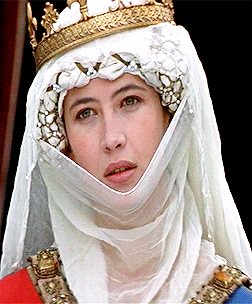
Wimples were drapes of material that covered a woman's hair, neck and sometimes her face. With its similarities to hijab, historians suspect that wimples might have been among the fashions that crusaders (dick-heads) brought back. Wimples were often worn to show modesty, with many nuns and religious women taking it as their signature look.
Balzo

These headdresses are circular rolls of materials fitted to be worn at the back of the wearer's head. They could be stitched with veils and precious stones.
Crespines/Cauls

These were popular for a long period of time, close to two centuries. These provided ladies with long hair to tidy it out of way. Women wore their hair on either side of their heads, held by thd crespines which could be made of mesh metal or cloth netting. The whole thing would be secured with a fillet, a length of material or metal fitted over the top of the head.
French Hood

The French hood is a crescent shaped headdress that sits atop the head, allowing the front half of the hair to be shown. The back was always stitched with a veil. The front half of the hood wasn't a fucking hairband (calling out Wolf Hall) but rather a significant height usually bejewelled and embroidered.
English/Gable Hood

This sort of looks like a roof but a rather regal roof. The ancestor to the French hood, it was the favourite headdress of Katherine of Aragon and Jane Seymour. It has always been one of the more regal looking headdresses to me.
Kokoshnik
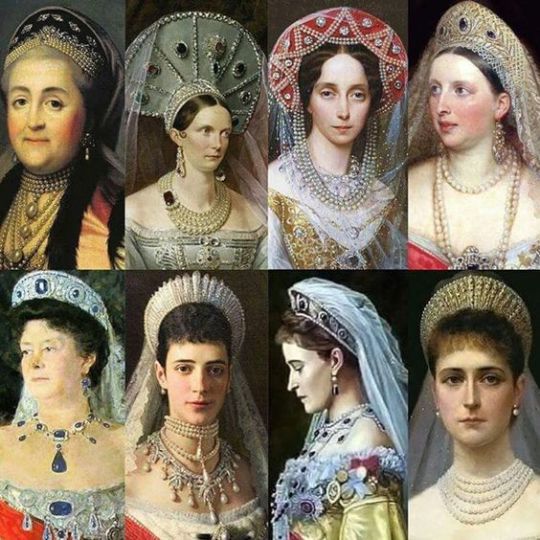
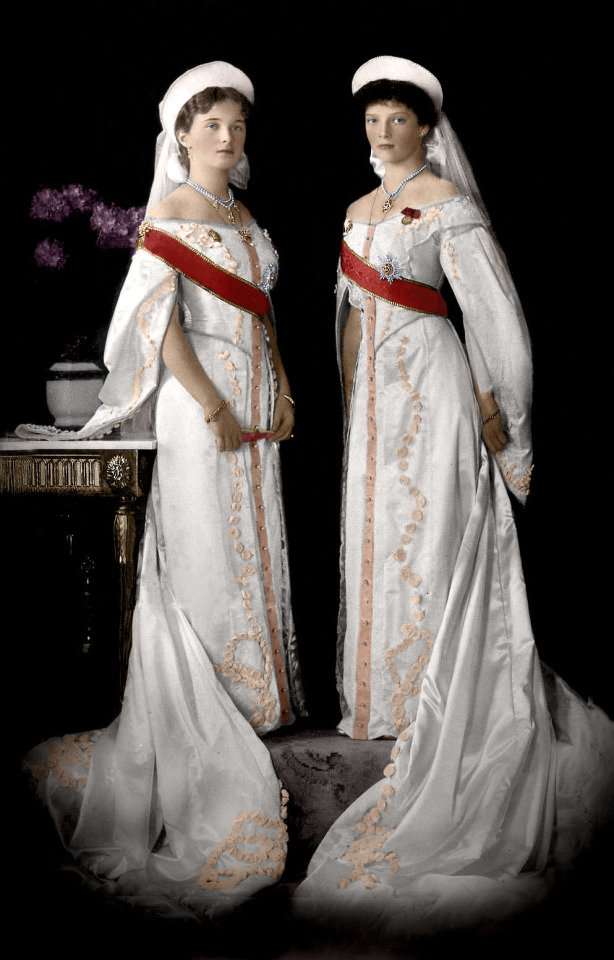
My favorite headdress of all time. It is Russian headdress of all different shapes, the most popular and common being the crescent shaped one. Most kokoshniks were accompanied by bands of beads or pearls laid across the forehead or a large bow at the back. I fucking love the kokoshnik.
#fantasy fashion#fantasy gown#fantasy#fantasy wardrobe#fantasy guide#woman's headdress 1#fashion#fantasy worldbuilding#worldbuilding#fantasy cultures#culture#kokoshnik#hennin#headdress#historical fantasy#historical#historical fashion#history dump#writes#writer#writing advice#writing advice writing reference#writing advice writing resources#writing resources writing reference#writing resources#writing resources writing advice#writing research#writer tips
3K notes
·
View notes
Photo
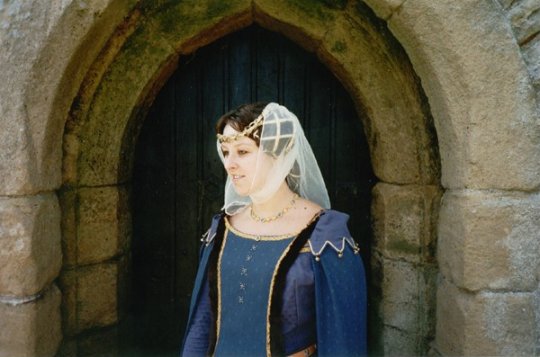
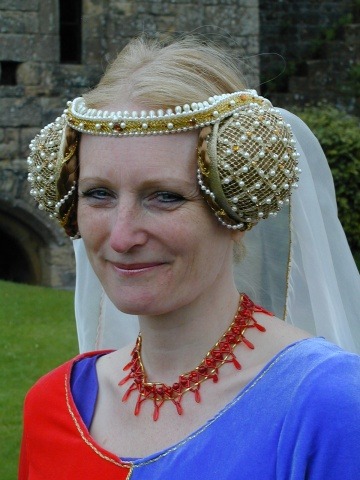
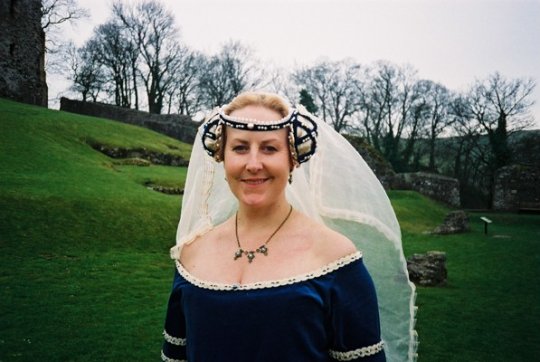
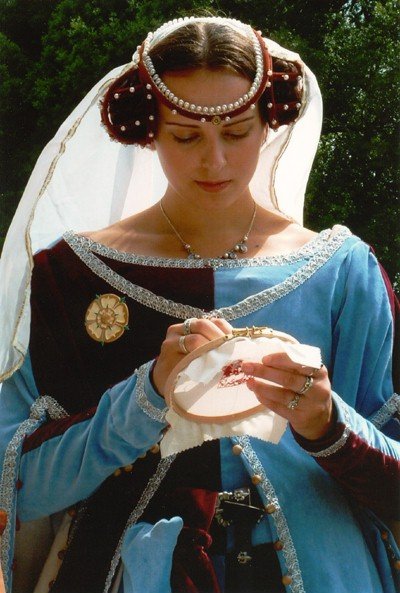
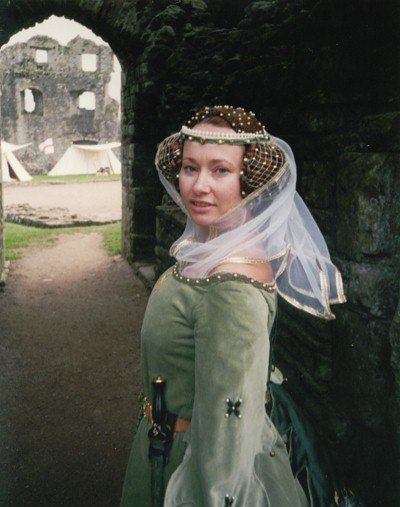



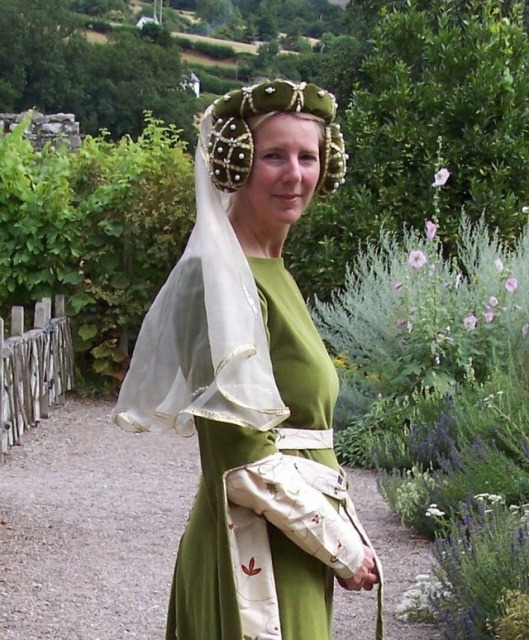

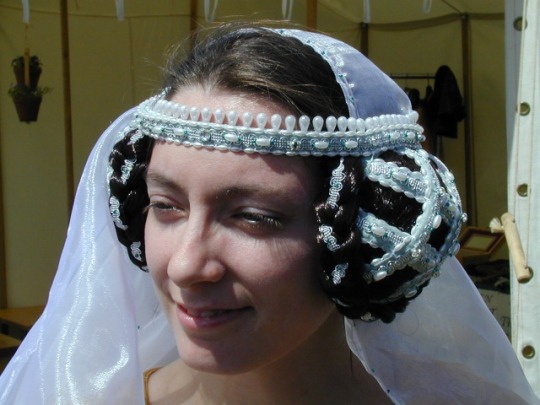
The Crispinette (or Caul) came into fashion in the second half of the 13th century (1250). It was originally known as the "Crispine", which was a network cap to confine the hair. These caps were shaped like bags or like hairnets. They were made of gold or silver mesh or hand woven silk.
By the 1300´s hair coiled over the ears in the "Ramshorns" was becoming increasingly bulky. It needed to be contained. The "Crispine" came to be adapted. In the previous reign, it was used to contain hair under the Torque, in a net at the back of the head. Now it became smaller and split into two parts. The hair was coiled into two gold cauls (nets) over each ear, held in place by a fillet (a narrow bar of metal in gold, silver or embroidery, according to the position of the wearer). This was the "Crispinette". A veil was also worn with the crispinette and again decorated to the position of the wearer.
Women of the 14th Century attached great importance to the dressing of their hair and wanted to be in the height of fashion. Princess Isabella (known as the "She wolf of France") brought this fashion of hair dressing to the English court when she married Prince Edward II, and because of her status, it became fashionable to dress the hair in this way.
By the time of Edward III, the Crispinette was still worn by all levels and ages of female society for day and State wear, along with the other headdresses of the time, the "Templars", the "Goffered" and the "Tressour Crispinette." A simpler form of Crispinette was worn by the middle and lower classes, where their hair took on the shape of "Ramshorns," plaited and coiled underneath their veils and head coverings.


(^Wife of Edward I in crispinette from the film Braveheart, a little too early for the Crispinettes, since it was her daughter-in-law who brought the fashion to England!)
The Crispinette was worn well into the time period of Richard II although the cauls became much larger and were worn higher over the ears. From this it developed into the reticulated headdress known as the "Cross Tree" or the "Gibbet" and of course, the "Heart Shaped Hennin."
(source)
410 notes
·
View notes
Text
watching the so-bad-it’s-good (to me) lady death animated movie again. obvious dante symbolism with hope’s unfortunate boyfriend niccolo and his cute l’il red beret. what’s an italian boy doing studying at the university of uppsala anyway
wanna draw hope in actual 15th century clothes. she could have one of those kinda horn like hennins (headress category that also includes the stereotypical conical princess hat with veil attached to the tip). like were the inspiration for maleficent as well vivienne from dragon age inquisition. and then draw her as lady death in 15th-century-inspired armor. that’d be fun to do. i don’t have any references for 15th century Sweden specifically but i’m assuming the nobility adopted fashions from the rest of europe and dressed about the same as english and french nobility.
well, at least the dialogue between matthias and the priest in the beginning scene is so bad it’s good. my favorite exchange:
matthias (hope’s dad who is the actual devil in disguise): “MATTHIAS SPEAKS AND GOD ANSWERS! SATISFIED, FATHER?”
priest: “PERHAPS YOU PRAY TO THE WRONG GOD.”
matthias: “GOD WORKS IN MYSTERIOUS WAYS.”
(OMINOUS THUNDER SOUND EFFECTS AS MATTHAIS RIDES AWAY)
priest: “FATHER IN HEAVEN, WHY HAVE YOU FORSAKEN US?”
(OLD WOMAN CRIES BY SAYING ‘UHUHUHU’ AS THE PRIEST COMFORTS HER. MORE THUNDER)
there’s some pretty graphic and intense violence in this movie and it just occurred to me i should warn people about that. there’s a lot of sexualized violence against women. most gruesome thing that happens is hope’s skin burning off when she’s being burned at the stake
#who doesn't have a go-to bad movie to hyperfixate on and watch over and over?#i've had a bunch#the first fantastic four movie and daredevil with ben affleck were those for me when i was a kid#my best friend and i watched fantastic four together when i slept over at her house#i was familiar with the fantastic four and she was not and we had wildly different reactions
1 note
·
View note
Text
Dolly Dharma, an expensive and cracked human plate, is also a relic found in New York, one gigantic operatic organ that defies description, its not 2018 yet and thus, cannot be understood with the words from then, here. Dolly believes all that is to be said about them though, has already been pooled into the performance aspect on display. For further description, please refer to the night you'll see a Dolly Dharma.
youtube
Night 1: the Mr. Bean theme plays, as she rises slowly from the floor with a turkey mask on her head. She inches her way towards a large white diamond-shaped dinner napkin held by two people on opposite ends. Disappearing behind it, she pops her turkey head out an already applied hole, and two smaller ones does her arms go. Only her hands are holding a large fork in one, and a large knife in the other. She begins to cut open where her mouth is. Whilist lip-syncing the remaining words of the song, in between of words, out pours a greenish-yellow liquid similar to that of turkey stuffing. She vomits. She looks down to examine the contents. A shiny thing, she exits from the large napkin, and goes over to it. A disappeared wrist watch. She bends down, combs over the upchucked contents and places it on. She determines from that watch that her performance is about up. She exits the stage.
Night 2: A figure walks out wearing a large hennin hat/princess cone, covering the head to the chest. On the stomach is a graphic of her face, smiling with some of the teeth alreadyout. Just off to the side by the feet lies a pillow. The arms that dangle at the side give the appearance of a baubo-like creature. These arms extend out just enough to grab a pair of pliers. She mocks pulling teeth out with it. Perhaps even the teeth are felt that come off easily. She puts down the pliers and whatever teeth have fallen, go under the aforementioned pillow. Yet from underneath there, out she pulls a money-gun as an apt replacement. She fires off in the dark club; bills with her likeness go everywhere. After having emptied the gun, she then takes the pillow and rips that apart, and feathers go everywhere else. She exits the stage.
- - -
Leprosy. Leprosy as a performance. We as the viewer are not yet ready to confront the feeling of being presented with an ugly performer; me as the performer will challenge that. By exploring operatic and surreal devices, we will examine a performance that utilizes no straight line, to illustrate what it means to be squeamish watching, or a living embodiment of that feeling. At no point in our lives were we given a concrete and simple image of people. More precedence goes to those who are deemed beautiful by society. I intend to put the worst of us on display. A performance that given society, wouldnt ordinarily happen if not for beautiful words to convey what is to be done. This is a feel-based experimentation, with a defined look at what it means to be given something with little explanation; a thing too ugly to be able to interpret in our own words. Can it still be as enjoyable as one without the human tradition of reason?. Are we predisposed to only enjoying things in our culture once they are spelled out to us like the idiots we are?. And were the audience to look for deeper meaning, they need only look between the butt cheeks of description to see more is at play. Intelligence is taking place, but are you smart enough to catch it, or will you be blind to it because of a performers inadequacy to be beautiful?.
youtube
Night 3: Again she appears, this time with a surgical mask and the black lips painted on to them. She begins on her knees, behind her, a woman on a podium sings a live cover of Leper Lord by Death in June, to which, she opens the masked lips via a zipper to lip sync to her live singing. After the first verse commences, she does a back bridge and slowly pulls down the mask over her eyes to reveal a face drawn on the mouth, so to lip sync while holding her body this way. And finally, upon the last verse, or, repeated chorus, she gets up and lifts up her dress. By then she has eyes on the back of her hands. The hands pull the buttocks open to give the the appearance of the butt also singing. When it is all over, and the podium singer is finished, Dolly bows. Her mouth bows, and her butt, bows. They exit the stage.
https://www.youtube.com/watch?v=chGXjem8pA4
Night 4: And now with her head in a white sheet over head she is. There is a picture of a tree painted on. It is here where she will sing live herself, a mournful rendition of Horila Sosna. At some point in the performance, she shifts to singing in english, for now it is the white sheet with tree. She’ll take it off to reveal another sheet, black, with burning trees all around the one unburnt. After singing some more with this covering, she takes it off to show a wedding veil over her face. This would be Dolly’s answer to a “wedding-themed” performance. She takes the veil off and puts it by her feet. She burns it, and puts it back on. Finishes up singing. She exits the stage.
~the woods were burning by the tree~
~the woods were burning by the tree~
~by the house and by the sea~
~by the house and by the sea~
~no longer a bridesmaid I will be~
~no longer a bridesmaid I will be~
~under the white veil I will go~
~to the only husband I will know~
0 notes
Text

When you've got a weird unpredictable force field floating around your head, but the Jeffers box came and THERE'S A NEW UNICORN?? Yeah, yeah, cone of shame, whatever. UNICORN.
#guinevere#cocker spaniel#dogblr#smush mouth#squish face#the Gwyn-sized unicorn#24 inch multipet unicorn toy#princess in her hennin and veil#the Blunder-Buss#the butt hurts#bad photography
32 notes
·
View notes
Text

Despite our best efforts, Gwyn is just not drinking enough water in this heat. She got a little nauseated Sunday afternoon, but still had pink gums and instant capillary refill time. So I redoubled my efforts to get her to drink in this e-collar in this heat. Aaaand I was unsuccessful. As of Monday morning, Gwyn started *gasp* REFUSING TREATS, and her gums were a little pale with a slightly increased CRT. So Gwyn got bundled into the car to visit the emergency department.

When we went back for the exam... Gwyn stayed relaxed while the vet checked her over, had NORMAL heart & respiration rates, even while the vet checked her (still ouchy) surgical site! I was astounded and alarmed; obviously Gwyn has not become chill with strangers in the seven days since she was last at the hospital. But... we couldn't find a reason for it, either. I was worried some underlying illness might be the reason she wasn't drinking enough, or something? But no, all that showed on her bloodwork was the dehydration. Which was great!



So Gwyn got fluids, and we went merrily exhaustedly home, and she's been asleep for four hours, which is also not like her. Tomorrow, I try to convince her to drink enough, again, and worry that there's something wrong that the blood tests didn't show. Again.
#guinevere#cocker spaniel#dogblr#the butt hurts#princess in her hennin and veil#vet visits#heat wave#drink your fluids#SNOOD#Florida summer#drink. your. fluids. please#gwyn has not suddenly acquired chill#so. WHAT THE FUCK.#this is bizarre#doggy ER
44 notes
·
View notes
Text
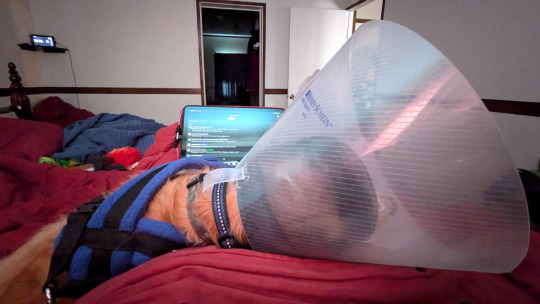
When you've got a weird unpredictable force field floating around your head, but you still need to "help" to Computer.
#guinevere#cocker spaniel#dogblr#princess in her hennin and veil#the butt hurts#'helping' to Computer#the Blunder-Buss
31 notes
·
View notes
Text


The face[*] of An Baby who *really* needs to poop, but is afraid of her butt, and is being soooo not-brave about it.
Pooping hurts her right now[**], and I can't do anything about it 😢 but I can stand by, make soothing noises, and give her a handful of treats when she is done. (This is slightly harder than it sounds, because I am also trying to pick the poo as it drops, and her usual squat-walking pooping style has become more of a squat-flee as she attempts to move away from whatever is hurting her 🥺) It seemed less painful today than yesterday, so I hope next time will be even less scary. And once it's all healed, she won't have this problem any more! I can't criticize her being not-brave; I wouldn't be brave about this, either.
[*] She just had one snood removed for rinsing, and the other is in my pocket to go on her momentarily.
[**] It was also very painful before the surgery every time the anal glands misbehaved, which was getting to be every two weeks or less. The temporary distress is worth it. But she doesn't know that.
#guinevere#cocker spaniel#dogblr#the butt hurts#princess in her hennin and veil#the Blunder-Buss#her not-bravery includes smacking sound-asleep me on the nipple with a paw.and when I objected knocking my tablet to the floor with he cone#and otherwise being agitated while trying to get our attention#ow
15 notes
·
View notes
Photo
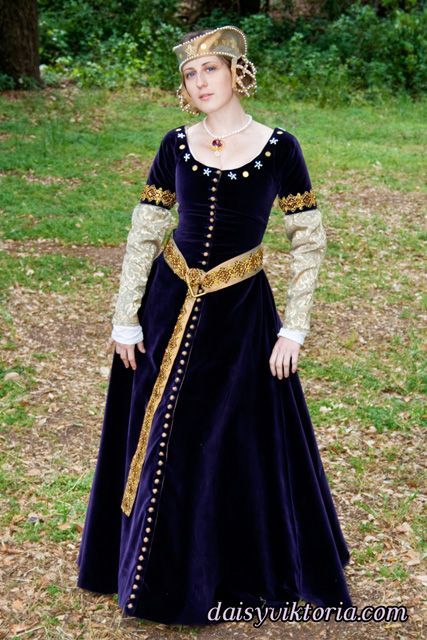
14th century cotehardie with a tressour crispinette
The "Crispinette" (or "Caul") came into fashion in the second half of the 13th century (1250). It was originally known as the "Crispine," which was a network cap to confine the hair. These caps were shaped like bags or like hairnets. They were made of gold, silver or coloured silk.
By the 14th century, the "Crispine" became the "Crispinette" and where the hair in the previous century was worn in a net at the back of the head, at the nape, it was now worn over the ears either in two coiled plaits or coiled into two gold cauls held by a fillet (a narrow bar of metal in gold or silver or embroidery according to the position of the wearer) This was the "Crispinette."
Women of the 14th century attached great importance to the dressing of their hair and wanted to be in the height of fashion. Princess Isabella (Known as the "she-wolf of France") brought this fashion to the English court when she married Prince Edward II, and because of her status it became fashionable to dress hair in this way.
All levels of society wore the "Crispinette". (A simpler form of Crispinette was worn by the middle and lower classes, where their hair took on the shape of "rams horns" plaited and coiled underneath their veils and head coverings.)
By the time of Edward III 1327-1377, it was still worn highly decorated with a full veil by women and had changed shape by having a taller sweeping fillet. This was known as the "Tressour Crispinette" and became the predecessor of the "Heart Shaped Hennin" from the early 15th century. In England the Tressour Crispinette can be referred to as 'Crepin, Cresine, and Tressure'. Tressour Crispinettes are also known as 'Tressours' or 'Tressures.' In Venice it was referred as 'Dressadori' and in Tuscany known as 'Intrezzatoi' or other terms are 'Tresson, tressoir, tressador, fresadura.' One Tressour Crispinette was worn with 175 pearls, with little blue and red Bosses or rosettes (like clusters of jewels about the fillet).
71 notes
·
View notes